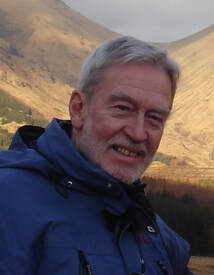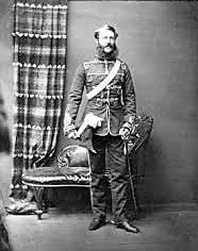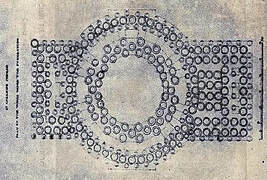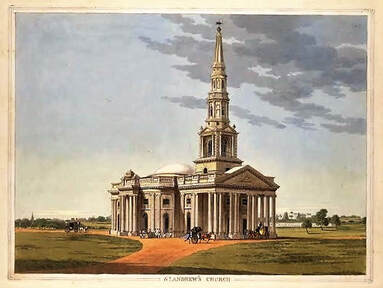The Bicentenary of St Andrew's Church (the Kirk)
In the City of Chennai (Madras) on India's Coromandel Coast
 Murdoch on a Climb to the Summit of Ben Nevis
Murdoch on a Climb to the Summit of Ben Nevis
Barry and Margaret Williamson
Locked Down in the Fylde
March 2021
On the 25th February 2021 a special service was held in the Kirk to celebrate the 200 years that have passed since, in the words of The Hindu newspaper, “it was consecrated as a Presbyterian place of worship for the many Scotsmen who made up the rank and file of the East India Company.”
Barry wrote the following comment on the YouTube page of the Kirk’s Bicentenary Commemorative Film:
“I really do appreciate the film. It takes me back to 1973/4 when I worked in Madras (as was) for a year and came to know the Minister, the Rev Murdoch MacKenzie, Anne and their three children. A fluent Tamil speaker, Murdoch did great work for the Kirk and for deprived people in the slum areas of the city.
With my wife Margaret, I revisited the Kirk in 1989/90 and again in 2005 and it is good to learn that both the building and the congregation continue to prosper after all these years. The work of the architect and builder, Thomas de Havilland, is among the best that the British could bring to India: his spire high above the conquered marsh is indeed an inspiration to this day!”
Locked Down in the Fylde
March 2021
On the 25th February 2021 a special service was held in the Kirk to celebrate the 200 years that have passed since, in the words of The Hindu newspaper, “it was consecrated as a Presbyterian place of worship for the many Scotsmen who made up the rank and file of the East India Company.”
Barry wrote the following comment on the YouTube page of the Kirk’s Bicentenary Commemorative Film:
“I really do appreciate the film. It takes me back to 1973/4 when I worked in Madras (as was) for a year and came to know the Minister, the Rev Murdoch MacKenzie, Anne and their three children. A fluent Tamil speaker, Murdoch did great work for the Kirk and for deprived people in the slum areas of the city.
With my wife Margaret, I revisited the Kirk in 1989/90 and again in 2005 and it is good to learn that both the building and the congregation continue to prosper after all these years. The work of the architect and builder, Thomas de Havilland, is among the best that the British could bring to India: his spire high above the conquered marsh is indeed an inspiration to this day!”
Links to Videos, Photographs and Further Information
The Bicentenary Commemorative Film of the Kirk (lasting 44 minutes)
https://www.youtube.com/watch?v=780_668IGG0&feature=youtu.be
Video of the Service held on 25th February 2021 at 5.45 pm (lasting 2 hours 23 minutes)
https://www.youtube.com/watch?v=ysD6tbUF6J0&list=PLDYlYFgPN6psFNpS-pA_0Fjt1HN3DRjoI
The Order of the St Andrew’s Commemorative Service on 25th February 2021
Click here to download a pdf copy of this document
Article in The Hindu Newspaper marking the Bicentenary of the Kirk
https://www.thehindu.com/news/cities/chennai/chennais-iconic-church-the-kirk-turns-200/article33922772.ece
The Memorial Website of Murdoch MacKenzie, Minister of the Kirk from 1972 to 1978
http://www.murdochmackenzieofargyll.com/
Seventeen Images of St Andrew’s Kirk on the Murdoch MacKenzie website
http://www.murdochmackenzieofargyll.com/images-of-st-andrews-kirk.html
The Kirk’s own Comprehensive Website
https://www.thekirk.in/
The Bicentenary Commemorative Film of the Kirk (lasting 44 minutes)
https://www.youtube.com/watch?v=780_668IGG0&feature=youtu.be
Video of the Service held on 25th February 2021 at 5.45 pm (lasting 2 hours 23 minutes)
https://www.youtube.com/watch?v=ysD6tbUF6J0&list=PLDYlYFgPN6psFNpS-pA_0Fjt1HN3DRjoI
The Order of the St Andrew’s Commemorative Service on 25th February 2021
Click here to download a pdf copy of this document
Article in The Hindu Newspaper marking the Bicentenary of the Kirk
https://www.thehindu.com/news/cities/chennai/chennais-iconic-church-the-kirk-turns-200/article33922772.ece
The Memorial Website of Murdoch MacKenzie, Minister of the Kirk from 1972 to 1978
http://www.murdochmackenzieofargyll.com/
Seventeen Images of St Andrew’s Kirk on the Murdoch MacKenzie website
http://www.murdochmackenzieofargyll.com/images-of-st-andrews-kirk.html
The Kirk’s own Comprehensive Website
https://www.thekirk.in/
 Major Thomas de Havilland
Major Thomas de Havilland
Major Thomas Fiott de Havilland, Architect and Builder of St Andrew’s Church
Born in Guernsey in 1775, Major de Havilland joined the East India Company in 1792 as a cadet at the age of 17. In appearance he was short and slight. At the age of 20 he was just under 5 feet 6 inches in height, and nine stone in weight. He possessed a strong constitution and great physical and mental energy. He was intelligent and clever.
Rising through the ranks as an Engineer, he had an adventurous life, seeing active service in Ceylon and Egypt as well as India. In 1804, returning to India from a furlough in England, his ship was taken by the French privateer, La Psyché, near Hog Island off Sumatra. A ransom had to be paid and he finally reached Calcutta en route to Madras in the Spring of 1804.
He was responsible for a number of building works in the city, including what he called the “Scotch National Church, or kirk, at Madras, dedicated to St Andrew”. It was based on plans for St Martin in-the-Fields, with a circular nave and a domed ceiling, despite that proving too expensive for St Martin's which was completed in December 1724 with a simpler, rectilinear plan at a cost of £33,661. St Andrew’s cost £20,000, a large portion of which was spent on the foundations created by digging 150 wells into marshy ground and filling them with brick and pottery.
Born in Guernsey in 1775, Major de Havilland joined the East India Company in 1792 as a cadet at the age of 17. In appearance he was short and slight. At the age of 20 he was just under 5 feet 6 inches in height, and nine stone in weight. He possessed a strong constitution and great physical and mental energy. He was intelligent and clever.
Rising through the ranks as an Engineer, he had an adventurous life, seeing active service in Ceylon and Egypt as well as India. In 1804, returning to India from a furlough in England, his ship was taken by the French privateer, La Psyché, near Hog Island off Sumatra. A ransom had to be paid and he finally reached Calcutta en route to Madras in the Spring of 1804.
He was responsible for a number of building works in the city, including what he called the “Scotch National Church, or kirk, at Madras, dedicated to St Andrew”. It was based on plans for St Martin in-the-Fields, with a circular nave and a domed ceiling, despite that proving too expensive for St Martin's which was completed in December 1724 with a simpler, rectilinear plan at a cost of £33,661. St Andrew’s cost £20,000, a large portion of which was spent on the foundations created by digging 150 wells into marshy ground and filling them with brick and pottery.
 Thomas de Havilland's Sketch of the 150 Wells for St Andrew's Foundation
Thomas de Havilland's Sketch of the 150 Wells for St Andrew's Foundation
Thomas de Havilland wrote a very detailed 37-page account of his work as the Kirk’s architect and builder. Peter Millar, Minister of the Kirk in 1982, photographed the document and thanks to him it can now be downloaded as a pdf from the Kirk’s website. Read it for an insight into the India of those long-ago days, and for its excellent use and command of the English language (whatever happened to that?)
https://www.thekirk.in/docs/The%20Kirk.pdf
Thomas de Havilland left India in 1822 and retired from the East India Company in 1825, aged 50. He returned to Guernsey and died there in 1866 at the age of 91.
In his autobiography written in 1854 , he wrote of the Kirk’s building:
“St Andrews is accounted a handsome building, and is of peculiar construction, being entirely of masonry, (chiefly brick,) save only the door and windows of teakwood, and the pulpit and pews of mahogany; the latter divided by arms into single sittings, and all ranged concentrically to the pulpit; the pavement was marble, black and white, checkered.
The outline of this edifice is an oblong square, with a spacious portico at the west end, and a sort of chancel at the east. Over the centre of his edifice, a circular dome, fifty-one feet of interior diameter, rises and forms part of the roof; it rests on a stone entablature, placed on the capitals of sixteen pillars of the Ionic order, in a circle, supporting it; and the whole superstructure is firmly kept in equilibrium by an annular arch, leaning against the outer walls, and supporting the terrace round the dome, which completes the roof.
https://www.thekirk.in/docs/The%20Kirk.pdf
Thomas de Havilland left India in 1822 and retired from the East India Company in 1825, aged 50. He returned to Guernsey and died there in 1866 at the age of 91.
In his autobiography written in 1854 , he wrote of the Kirk’s building:
“St Andrews is accounted a handsome building, and is of peculiar construction, being entirely of masonry, (chiefly brick,) save only the door and windows of teakwood, and the pulpit and pews of mahogany; the latter divided by arms into single sittings, and all ranged concentrically to the pulpit; the pavement was marble, black and white, checkered.
The outline of this edifice is an oblong square, with a spacious portico at the west end, and a sort of chancel at the east. Over the centre of his edifice, a circular dome, fifty-one feet of interior diameter, rises and forms part of the roof; it rests on a stone entablature, placed on the capitals of sixteen pillars of the Ionic order, in a circle, supporting it; and the whole superstructure is firmly kept in equilibrium by an annular arch, leaning against the outer walls, and supporting the terrace round the dome, which completes the roof.
 An Early Painting of St Andrew's Church
An Early Painting of St Andrew's Church
Between the portico and the dome is the belfry tower, surmounted by a handsome steeple, whose weathercock is about one hundred and seventy feet above the surface of the ground. The whole masonry of this church is endued with excellent shell stucco, or cement, inside and out; and the interior of the dome is coloured, to represent the blue firmament. The whole cost of this kirk was about £20,000; a large portion of which sum was absorbed in the foundations, which are sunk on wells (150!), some twenty or twenty-five feet deep, through a stratum of black salt mud, and some sand; a marine deposit, which seems to have been there for the untold centuries of an almost unimaginable period.
The foundation stone was laid with all due ceremony on the 6th April, 1818; and the work was completely finished within two years, to the satisfaction of Government and elders of that Church.”
Thomas de Havilland’s original full autobiography of 3,643 words can be found at:
https://www.priaulxlibrary.co.uk/articles/article/autobiography-thomas-fiott-de-havilland-engineer-and-architect
This source also gives a fascinating account of Thomas’s wife, Elizabeth, who joined him for marriage in India in 1808. She bore him six children (four boys and two girls), three of whom were born in India and three in Guernsey. Elizabeth died in India in 1818, a month before the foundation stone of St Andrew’s was laid. She was buried in Madras at the Anglican St George’s Cathedral, which Thomas had also designed and built (it was consecrated on 6 January, 1816).
“Elizabeth de Sausmarez (1782-1818), Mrs Thomas Fiott de Havilland. Daughter of Thomas de Sausmarez and his first wife, Martha Dobrée. She was known to her brothers and sisters as Betsy, but to her husband as Eliza. In 1797/98 she spent a year at school in England, and after leaving school spent a couple of months with her Uncle Rowley in Malling before returning home. As a young woman Elizabeth was, in the words of her step-mother, 'everything that a fond parent could wish, a fine, amiable, sensible girl.' She was attentive and kind and an excellent artist. Of her personal appearance we know little. She was taller than her great friend Nancy de Havilland, and had dark eyes.
In the spring of 1803 she fell in love with Thomas de Havilland, who wanted to marry her and take her back with him to India. However both Thomas de Sausmarez and Peter de Havilland felt that Thomas did not yet have a sufficient income and decided that he should return alone, better his position and then come home to marry Elizabeth. Thomas had to agree. The engagement remained a secret. Thomas’ prospects were damaged by his capture on the way to India and he realised that it would be a long time before he could leave India for good. He pressed constantly for Elizabeth to be sent out to him and eventually in 1807 Thomas de Sausmarez relented.
Elizabeth sailed for India on board the William Pitt in March 1808, and arrived at Madras at the end of August. She and Thomas were married at Madras on 3rd September. Elizabeth’s first child, a son, was born in August or September 1809. Elizabeth was seriously ill for several months after the birth, and the baby died on 24th October. In May Thomas resigned his commission and he and Elizabeth, who was again pregnant returned home. They arrived in September or early October and the child, a girl was born on 16th November and christened Emilia.
Thomas and Elizabeth remained four years in Guernsey and set sail for India in May 1814, arriving at Madras in September. Their other children were: Thomas, born 31st May 1812 in Guernsey; John, born in Guernsey, October 1813, died 1814; Elizabeth, born in India 26th November 1815; Charles Ross, born in India 23rd June 1817. Elizabeth died in India on 14th March 1818 aged 36. Thomas said the cause of death was an abscess of the liver.”
Sadly, in his 1854 autobiography, Thomas wrote: “my own immediate descendants may be but few, having survived my only two sons, Thomas and Charles Ross, who, between them, have left only one child.”
The foundation stone was laid with all due ceremony on the 6th April, 1818; and the work was completely finished within two years, to the satisfaction of Government and elders of that Church.”
Thomas de Havilland’s original full autobiography of 3,643 words can be found at:
https://www.priaulxlibrary.co.uk/articles/article/autobiography-thomas-fiott-de-havilland-engineer-and-architect
This source also gives a fascinating account of Thomas’s wife, Elizabeth, who joined him for marriage in India in 1808. She bore him six children (four boys and two girls), three of whom were born in India and three in Guernsey. Elizabeth died in India in 1818, a month before the foundation stone of St Andrew’s was laid. She was buried in Madras at the Anglican St George’s Cathedral, which Thomas had also designed and built (it was consecrated on 6 January, 1816).
“Elizabeth de Sausmarez (1782-1818), Mrs Thomas Fiott de Havilland. Daughter of Thomas de Sausmarez and his first wife, Martha Dobrée. She was known to her brothers and sisters as Betsy, but to her husband as Eliza. In 1797/98 she spent a year at school in England, and after leaving school spent a couple of months with her Uncle Rowley in Malling before returning home. As a young woman Elizabeth was, in the words of her step-mother, 'everything that a fond parent could wish, a fine, amiable, sensible girl.' She was attentive and kind and an excellent artist. Of her personal appearance we know little. She was taller than her great friend Nancy de Havilland, and had dark eyes.
In the spring of 1803 she fell in love with Thomas de Havilland, who wanted to marry her and take her back with him to India. However both Thomas de Sausmarez and Peter de Havilland felt that Thomas did not yet have a sufficient income and decided that he should return alone, better his position and then come home to marry Elizabeth. Thomas had to agree. The engagement remained a secret. Thomas’ prospects were damaged by his capture on the way to India and he realised that it would be a long time before he could leave India for good. He pressed constantly for Elizabeth to be sent out to him and eventually in 1807 Thomas de Sausmarez relented.
Elizabeth sailed for India on board the William Pitt in March 1808, and arrived at Madras at the end of August. She and Thomas were married at Madras on 3rd September. Elizabeth’s first child, a son, was born in August or September 1809. Elizabeth was seriously ill for several months after the birth, and the baby died on 24th October. In May Thomas resigned his commission and he and Elizabeth, who was again pregnant returned home. They arrived in September or early October and the child, a girl was born on 16th November and christened Emilia.
Thomas and Elizabeth remained four years in Guernsey and set sail for India in May 1814, arriving at Madras in September. Their other children were: Thomas, born 31st May 1812 in Guernsey; John, born in Guernsey, October 1813, died 1814; Elizabeth, born in India 26th November 1815; Charles Ross, born in India 23rd June 1817. Elizabeth died in India on 14th March 1818 aged 36. Thomas said the cause of death was an abscess of the liver.”
Sadly, in his 1854 autobiography, Thomas wrote: “my own immediate descendants may be but few, having survived my only two sons, Thomas and Charles Ross, who, between them, have left only one child.”